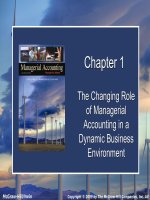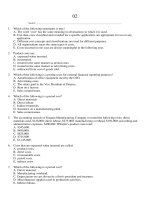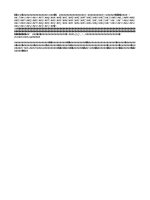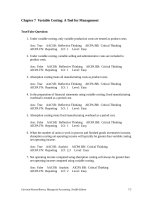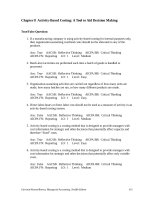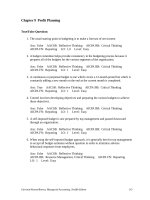TEST BANK MANAGERIAL ACCOUNTING CREATING VALUE IN a DYNAMIC BUSINESS ENVIRONMENT 10THChap002
Bạn đang xem bản rút gọn của tài liệu. Xem và tải ngay bản đầy đủ của tài liệu tại đây (6.46 MB, 127 trang )
Chapter 02
Basic Cost Management Concepts
True / False Questions
1. Inventoriable costs are expensed when incurred.
True
False
2. Finished goods inventory is ordinarily held for sale by a manufacturing company.
True
False
3. Indirect labor is not a component of manufacturing overhead.
True
False
4. The following equation—Beginning finished goods + cost of goods manufactured ending finished goods—is used to calculate cost of goods sold during the period.
True
False
5. A suitable cost driver for the amount of direct materials used is the number of direct
labor hours worked.
True
False
Multiple Choice Questions
2-1
Copyright © 2014 McGraw-Hill Education. All rights reserved. No reproduction or distribution without the prior written consent of
McGraw-Hill Education.
6. Which of the following statements is true?
A. The word "cost" has the same meaning in all situations in which
it is used.
B. Cost data, once classified and recorded for a specific application, are appropriate
for use in any application.
C. Different cost concepts and classifications are used for different
purposes.
D. All organizations incur the same types of
costs.
E. Costs incurred in one year are always meaningful in the
following year.
7. Product costs are:
A. expensed when
incurred.
B. inventorie
d.
C. treated in the same manner as period
costs.
D. treated in the same manner as advertising
costs.
E. subtracted from cost of goods
sold.
8. Which of the following is a product cost?
A. Glass in an
automobile.
B. Advertisin
g.
C. The salary of the vice presidentfinance.
D. Rent on a
factory.
E. Advertising and rent on a
factory.
2-2
Copyright © 2014 McGraw-Hill Education. All rights reserved. No reproduction or distribution without the prior written consent of
McGraw-Hill Education.
9. Which of the following would not be classified as a product cost?
A. Direct
materials.
B. Direct
labor.
C. Indirect
materials.
D. Insurance on a manufacturing
plant.
E. Sales
commissions.
10. The accounting records of Georgia Company revealed the following costs: direct
materials used, $250,000; direct labor, $425,000; manufacturing overhead, $375,000;
and selling and administrative expenses, $220,000. Georgia's product costs total:
A. $1,050,00
0.
B. $830,00
0.
C. $895,00
0.
D. $1,270,00
0.
E. None of the other answers are
correct.
11. Costs that are expensed when incurred are called:
A. product
costs.
B. direct
costs.
C. inventoriable
costs.
D. period
costs.
E. indirect
costs.
2-3
Copyright © 2014 McGraw-Hill Education. All rights reserved. No reproduction or distribution without the prior written consent of
McGraw-Hill Education.
12. Which of the following is a period cost?
A. Direct
material.
B. Advertising
expense.
C. Indirect
labor.
D. Miscellaneous supplies used in production
activities.
E. Advertising expense and indirect
labor.
13. Which of the following is not a period cost?
A. Legal
costs.
B. Public relations
costs.
C. Sales
commissions.
D. Wages of assembly-line
workers.
E. The salary of a company's chief financial officer
(CFO).
14. The accounting records of Reynolds Corporation revealed the following selected costs:
Sales commissions, $65,000; plant supervision, $190,000; and administrative
expenses, $185,000. Reynolds's period costs total:
A. $250,00
0.
B. $440,00
0.
C. $375,00
0.
D. $255,00
0.
E. $185,00
0.
2-4
Copyright © 2014 McGraw-Hill Education. All rights reserved. No reproduction or distribution without the prior written consent of
McGraw-Hill Education.
15. Yang Corporation recently computed total product costs of $567,000 and total period
costs of $420,000, excluding $35,000 of sales commissions that were overlooked by
the company's administrative assistant. On the basis of this information, Yang's
income statement should reveal operating expenses of:
A. $35,00
0.
B. $420,00
0.
C. $455,00
0.
D. $567,00
0.
E. $602,00
0.
16. Which of the following entities would most likely have raw materials, work in process,
and finished goods?
A. Exxon
Corporation.
B. Macy's Department
Store.
C. Wendy'
s.
D. Southwest
Airlines.
E. Columbia
University.
17. Selling and administrative expenses would likely appear on the balance sheet of:
A. The
Gap.
B. Texas
Instruments.
C. Turner Broadcasting
System.
D. All of these
firms.
E. None of these
firms.
2-5
Copyright © 2014 McGraw-Hill Education. All rights reserved. No reproduction or distribution without the prior written consent of
McGraw-Hill Education.
18. Which of the following inventories would a discount retailer such as Wal-Mart report as
an asset?
A. Raw
materials.
B. Work in
process.
C. Finished
goods.
D. Merchandise
inventory.
E. All of the other answers are
correct.
19. Which of the following inventories would a company ordinarily hold for sale?
A. Raw
materials.
B. Work in
process.
C. Finished
goods.
D. Raw materials and finished
goods.
E. Work in process and finished
goods.
20. Which of the four items listed below is not a type of production process?
A. Batc
h.
B. Job
Shop.
C. Continuous
Flow.
D. Job
Flow.
2-6
Copyright © 2014 McGraw-Hill Education. All rights reserved. No reproduction or distribution without the prior written consent of
McGraw-Hill Education.
21. Which type of production process is ideal for a low production volume and one of a
kind products?
A. Batc
h.
B. Continuous
Flow.
C. Job
Shop.
D. Assembl
y.
22. Mideast Motors manufactures automobiles. Which of the following would not be
classified as direct materials by the company?
A. Wheel
lubricant.
B. Tires
.
C. Interior
leather.
D. CD
player.
E. Sheet metal used in the automobile's
body.
23. Which of the following employees of a commercial printer/publisher would be
classified as direct labor?
A. Book
binder.
B. Plant security
guard.
C. Sales
representative.
D. Plant
supervisor.
E. Payroll
supervisor.
2-7
Copyright © 2014 McGraw-Hill Education. All rights reserved. No reproduction or distribution without the prior written consent of
McGraw-Hill Education.
24. Lake Appliance produces washers and dryers in an assembly-line process. Labor costs
incurred during a recent period were: corporate executives, $500,000; assembly-line
workers, $180,000; security guards, $45,000; and plant supervisor, $110,000. The
total of Lake's direct labor cost was:
A. $110,00
0.
B. $180,00
0.
C. $155,00
0.
D. $235,00
0.
E. $735,00
0.
25. Which of the following employees would not be classified as indirect labor?
A. Plant
Custodian.
B. Salesperso
n.
C. Assembler of wooden
furniture.
D. Plant security
guard.
E. Salesperson and assembler of wooden
furniture.
26. Depreciation of factory equipment would be classified as:
A. operating
cost.
B. "other"
cost.
C. manufacturing
overhead.
D. period
cost.
E. administrative
cost.
2-8
Copyright © 2014 McGraw-Hill Education. All rights reserved. No reproduction or distribution without the prior written consent of
McGraw-Hill Education.
27. Which of the following costs is not a component of manufacturing overhead?
A. Indirect
materials.
B. Factory
utilities.
C. Factory
equipment.
D. Indirect
labor.
E. Property taxes on the manufacturing
plant.
28. The accounting records of Diego Company revealed the following costs, among
others:
Costs that would be considered in the calculation of manufacturing overhead total:
A. $149,00
0.
B. $171,00
0.
C. $186,00
0.
D. $442,00
0.
E. None of the other answers are
correct.
2-9
Copyright © 2014 McGraw-Hill Education. All rights reserved. No reproduction or distribution without the prior written consent of
McGraw-Hill Education.
29. Which of the following statements is(are) correct?
A. Overtime premiums should be treated as a component of manufacturing
overhead.
B. Overtime premiums should be treated as a component of
direct labor.
C. Idle time should be treated as a component of
direct labor.
D. Idle time should be accounted for as a special type
of loss.
E. Overtime premiums should be treated as a component of direct labor and idle time
should be treated as a component of direct labor.
30. Conversion costs are:
A. direct material, direct labor, and manufacturing
overhead.
B. direct material and direct
labor.
C. direct labor and manufacturing
overhead.
D. prime
costs.
E. period
costs.
31. Prime costs are comprised of:
A. direct materials and manufacturing
overhead.
B. direct labor and manufacturing
overhead.
C. direct materials, direct labor, and manufacturing
overhead.
D. direct materials and direct
labor.
E. direct materials and indirect
materials.
2-10
Copyright © 2014 McGraw-Hill Education. All rights reserved. No reproduction or distribution without the prior written consent of
McGraw-Hill Education.
32. Which of the following statements is true?
A. Product costs affect only the balance
sheet.
B. Product costs affect only the income
statement.
C. Period costs affect only the balance
sheet.
D. Neither product costs nor period costs affect the Statement of Retained Earnings.
This can also be a true statement if the period costs were prepaid (i.e., prepaid
advertising, depreciation).
E. Product costs eventually affect both the balance sheet and the income
statement.
33. In a manufacturing company, the cost of goods completed during the period would
include which of the following elements?
A. Raw materials
used.
B. Beginning finished goods
inventory.
C. Marketing
costs.
D. Depreciation of delivery
trucks.
E. All of the other answers are
correct.
34. Which of the following equations is used to calculate cost of goods sold during the
period?
A. Beginning finished goods + cost of goods manufactured + ending
finished goods.
B. Beginning finished goods - ending finished
goods.
C. Beginning finished goods + cost of goods
manufactured.
D. Beginning finished goods + cost of goods manufactured - ending
finished goods.
E. Beginning finished goods + ending finished goods - cost of goods
manufactured.
2-11
Copyright © 2014 McGraw-Hill Education. All rights reserved. No reproduction or distribution without the prior written consent of
McGraw-Hill Education.
35. Work-in-process inventory is composed of:
A. direct material and direct
labor.
B. direct labor and manufacturing
overhead.
C. direct material and manufacturing
overhead.
D. direct material, direct labor, and manufacturing
overhead.
E. direct material
only.
36. Holden Industries began July with a finished-goods inventory of $48,000. The finishedgoods inventory at the end of July was $56,000 and the cost of goods sold during the
month was $125,000. The cost of goods manufactured during July was:
A. $104,00
0.
B. $125,00
0.
C. $117,00
0.
D. $133,00
0.
E. None of the other answers are
correct.
37. Carolina Plating Company reported a cost of goods manufactured of $520,000, with
the firm's year-end balance sheet revealing work in process and finished goods of
$70,000 and $134,000, respectively. If supplemental information disclosed raw
materials used in production of $80,000, direct labor of $140,000, and manufacturing
overhead of $240,000, the company's beginning work in process must have been:
A. $130,00
0.
B. $10,00
0.
C. $66,00
0.
D. $390,00
0.
E. None of the other answers are
correct.
2-12
Copyright © 2014 McGraw-Hill Education. All rights reserved. No reproduction or distribution without the prior written consent of
McGraw-Hill Education.
38. The accounting records of Bronco Company revealed the following information:
Bronco's cost of goods manufactured is:
A. $519,00
0.
B. $522,00
0.
C. $568,00
0.
D. $571,00
0.
E. None of the other answers are
correct.
2-13
Copyright © 2014 McGraw-Hill Education. All rights reserved. No reproduction or distribution without the prior written consent of
McGraw-Hill Education.
39. The accounting records of Dolphin Company revealed the following information:
Dolphin's cost of goods sold is:
A. $508,00
0.
B. $529,00
0.
C. $531,00
0.
D. $553,00
0.
E. None of the other answers are
correct.
40. The accounting records of Brownwood Company revealed the following information:
Brownwood's cost of goods sold is:
A. $721,00
0.
B. $730,00
0.
C. $778,00
0.
D. $787,00
0.
E. None of the other answers are
correct.
2-14
Copyright © 2014 McGraw-Hill Education. All rights reserved. No reproduction or distribution without the prior written consent of
McGraw-Hill Education.
41. For the year just ended, Cole Corporation's manufacturing costs (raw materials used,
direct labor, and manufacturing overhead) totaled $1,500,000. Beginning and ending
work-in-process inventories were $60,000 and $90,000, respectively. Cole's balance
sheet also revealed respective beginning and ending finished-goods inventories of
$250,000 and $180,000. On the basis of this information, how much would the
company report as cost of goods manufactured (CGM) and cost of goods sold (CGS)?
A. CGM, $1,430,000; CGS,
$1,460,000.
B. CGM, $1,470,000; CGS,
$1,540,000.
C. CGM, $1,530,000; CGS,
$1,460,000.
D. CGM, $1,570,000; CGS,
$1,540,000.
E. Some other
amounts.
42.
If purchases of raw materials were $135,000 during the year, what was the amount of
raw materials used during the year?
A. $129,20
0.
B. $140,80
0.
C. $135,00
0.
D. $146,60
0.
E. None of the other answers are
correct.
2-15
Copyright © 2014 McGraw-Hill Education. All rights reserved. No reproduction or distribution without the prior written consent of
McGraw-Hill Education.
43.
If raw materials used during the year were $135,000 what was the amount of raw
materials purchased during the year?
A. $129,20
0.
B. $140,80
0.
C. $135,00
0.
D. $146,60
0.
E. None of the other answers are
correct.
44.
If direct materials used during the year were $135,000, what was cost of goods
manufactured?
A. $140,50
0.
B. $539,00
0.
C. $409,50
0.
D. $544,50
0.
E. None of the other answers are
correct.
2-16
Copyright © 2014 McGraw-Hill Education. All rights reserved. No reproduction or distribution without the prior written consent of
McGraw-Hill Education.
45.
If the cost of goods manufactured for the year was $565,000, what was the amount of
direct materials used during the year?
A. $155,50
0.
B. $140,50
0.
C. $150,00
0.
D. $145,50
0.
E. None of the other answers are
correct.
46.
If the cost of goods manufactured for the year was $385,000, what was the cost of
goods sold for the year?
A. $395,40
0.
B. $385,00
0.
C. $390,20
0.
D. $400,60
0.
E. None of the other answers are
correct.
2-17
Copyright © 2014 McGraw-Hill Education. All rights reserved. No reproduction or distribution without the prior written consent of
McGraw-Hill Education.
47.
If the cost of goods sold for the year was $427,500, what was the cost of goods
manufactured for the year?
A. $402,10
0.
B. $422,30
0.
C. $417,10
0.
D. $427,50
0.
E. None of the other answers are
correct.
48. Glass Industries reported the following data for the year just ended: sales revenue,
$1,750,000; cost of goods sold, $980,000; cost of goods manufactured, $560,000; and
selling and administrative expenses, $170,000. Glass' gross margin would be:
A. $940,00
0.
B. $1,190,00
0.
C. $1,020,00
0.
D. $380,00
0.
E. $770,00
0.
2-18
Copyright © 2014 McGraw-Hill Education. All rights reserved. No reproduction or distribution without the prior written consent of
McGraw-Hill Education.
49. Pumpkin Enterprises began operations on January 1, 20x1, with all of its activities
conducted from a single facility. The company's accountant concluded that the year's
building depreciation should be allocated as follows: selling activities, 20%;
administrative activities, 35%; and manufacturing activities, 45%. If Pumpkin sold
60% of 20x1 production during that year, what percentage of the depreciation would
appear (either directly or indirectly) on the 20x1 income statement?
A. 27%
.
B. 45%
.
C. 55%
.
D. 82%
.
E. 100
%.
50. An employee accidentally overstated the year's advertising expense by $50,000.
Which of the following correctly depicts the effect of this error?
A. Cost of goods manufactured will be overstated by
$50,000.
B. Cost of goods sold will be overstated by
$50,000.
C. Both cost of goods manufactured and cost of goods sold will be overstated
by $50,000.
D. Cost of goods sold will be overstated by $50,000, and cost of goods manufactured
will be understated by $50,000.
E. None of the other answers are
correct.
51. Which of the following would likely be a suitable cost driver for the amount of direct
materials used?
A. The number of units
sold.
B. The number of direct labor hours
worked.
C. The number of machine hours
worked.
D. The number of units
produced.
E. The number of employees working in the
factory.
2-19
Copyright © 2014 McGraw-Hill Education. All rights reserved. No reproduction or distribution without the prior written consent of
McGraw-Hill Education.
52. The choices below depict five costs of Benton Corporation and a possible driver for
each cost. Which of these choices likely contains an inappropriate cost driver?
A. Gasoline consumed; number of miles
driven.
B. Manufacturing overhead incurred in a heavily automated facility; direct
labor hours.
C. Sales commissions; gross sales
revenue.
D. Building maintenance cost; building square
footage.
E. Human resources department cost; number of
employees.
53. Variable costs are costs that:
A. vary inversely with changes in
activity.
B. vary directly with changes in
activity.
C. remain constant as activity
changes.
D. decrease on a per-unit basis as activity
increases.
E. increase on a per-unit basis as activity
increases.
54. As activity decreases, unit variable cost:
A. increases proportionately with
activity.
B. decreases proportionately with
activity.
C. remains
constant.
D. increases by a fixed
amount.
E. decreases by a fixed
amount.
2-20
Copyright © 2014 McGraw-Hill Education. All rights reserved. No reproduction or distribution without the prior written consent of
McGraw-Hill Education.
55. As activity increases, unit variable cost:
A. increases proportionately with
activity.
B. decreases proportionately with
activity.
C. remains
constant.
D. increases by a fixed
amount.
E. decreases by a fixed
amount.
56. Which of the following is not an example of a variable cost?
A. Straight-line depreciation on a machine that has a five-year
service life.
B. Wages of manufacturing workers whose pay is based on hours
worked.
C. Tires used in the production of
tractors.
D. Aluminum used to make patio
furniture.
E. Commissions paid to sales
personnel.
57. Fixed costs are costs that:
A. vary directly with changes in
activity.
B. vary inversely with changes in
activity.
C. remain constant on a per-unit
basis.
D. remain constant as activity
changes.
E. increase on a per-unit basis as activity
increases.
2-21
Copyright © 2014 McGraw-Hill Education. All rights reserved. No reproduction or distribution without the prior written consent of
McGraw-Hill Education.
58. The fixed cost per unit:
A. will increase as activity
increases.
B. will increase as activity
decreases.
C. will decrease as activity
increases.
D. will remain
constant.
E. will increase as activity decreases and will decrease as activity
increases.
59. Which of the following is an example of a fixed cost?
A. Paper used in the manufacture of
textbooks.
B. Property taxes paid by a firm to the City of Los
Angeles.
C. The wages of part-time workers who are paid $8
per hour.
D. Gasoline consumed by salespersons'
cars.
E. Surgical supplies used in a hospital's operating
room.
60. The true statement about cost behavior is that:
A. variable costs are constant on a per-unit basis and change in total as
activity changes.
B. fixed costs are constant on a per-unit basis and change in total as
activity changes.
C. fixed costs are constant on a per-unit basis and constant in total as
activity changes.
D. variable costs change on a per-unit basis and change in total as
activity changes.
E. variable costs are constant on a per-unit basis and are constant in total as
activity changes.
2-22
Copyright © 2014 McGraw-Hill Education. All rights reserved. No reproduction or distribution without the prior written consent of
McGraw-Hill Education.
61. The true statement about cost behavior is that:
A. variable costs change on a per-unit basis and change in total as
activity changes.
B. fixed costs are constant on a per-unit basis and change in total as
activity changes.
C. fixed costs are constant on a per-unit basis and are constant in total as
activity changes.
D. fixed costs change on a per-unit basis and are constant in total as
activity changes.
E. variable costs are constant on a per-unit basis and are constant in total as
activity changes.
62. The variable costs per unit are $6 when a company produces 12,000 units of product.
What are the variable costs per unit when 14,000 units are produced?
A. $4.5
0.
B. $5.0
0.
C. $5.5
0.
D. $6.0
0.
E. None of the other answers are
correct.
63. The fixed costs per unit are $10 when a company produces 10,000 units of product.
What are the fixed costs per unit when 8,000 units are produced?
A. $12.5
0.
B. $10.0
0.
C. $8.0
0.
D. $6.5
0.
E. $5.5
0.
2-23
Copyright © 2014 McGraw-Hill Education. All rights reserved. No reproduction or distribution without the prior written consent of
McGraw-Hill Education.
64. Total costs are $180,000 when 10,000 units are produced; of this amount, variable
costs are $64,000. What are the total costs when 13,000 units are produced?
A. $199,20
0.
B. $214,80
0.
C. $234,00
0.
D. None of the other answers are
correct.
E. Total costs cannot be calculated based on the information
presented.
65. When 5,000 units are produced variable costs are $35 per unit and total costs are
$200,000. What are the total costs when 8,000 units are produced?
A. $200,00
0.
B. $305,00
0.
C. $240,00
0.
D. None of the other answers are
correct.
E. Total costs cannot be calculated based on the information
presented.
66. Baxter Company, which pays a 10% commission to its salespeople, reported sales
revenues of $210,000 for the period just ended. If fixed and variable sales expenses
totaled $56,000, what would these expenses total at sales of $168,000?
A. $16,80
0.
B. $35,00
0.
C. $44,80
0.
D. $51,80
0.
E. None of the other answers are
correct.
2-24
Copyright © 2014 McGraw-Hill Education. All rights reserved. No reproduction or distribution without the prior written consent of
McGraw-Hill Education.
67. Which of the following would not be characterized as a cost object?
A. An automobile manufactured by General
Motors.
B. The New York Fire
Department.
C. A Burger King restaurant located in
Cleveland, Ohio.
D. A Delta Airlines flight from Atlanta to
Miami.
E. All of these are examples of cost
objects.
68. Costs that can be easily traced to a specific department are called:
A. direct
costs.
B. indirect
costs.
C. product
costs.
D. manufacturing
costs.
E. processing
costs.
69. Which of the following would not be considered a direct cost with respect to the
service department of a new car dealership?
A. Wages of repair
technicians.
B. Property taxes paid by the
dealership.
C. Repair parts
consumed.
D. Salary of the department
manager.
E. Depreciation on new equipment used to analyze engine
problems.
2-25
Copyright © 2014 McGraw-Hill Education. All rights reserved. No reproduction or distribution without the prior written consent of
McGraw-Hill Education.
